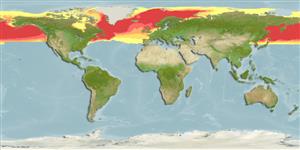分類 / Names
俗名 | 同種異名 | Catalog of Fishes(屬, 種) | ITIS | CoL | WoRMS | Cloffa
Teleostei >
Osmeriformes (Freshwater smelts)
胡瓜魚目 (Freshwater smelts) >
Osmeridae (Smelts)
胡瓜魚科 (Smelts)
Etymology: Mallotus: Greek for fleecy, derived from mallos = wool, and -otus = a Greek adjectival suffix referring to property; referring to the shape of the scales along the side of breeding males, appearing hairy or fleecy (S.Kullander, pers. Comm.).
Environment: milieu / climate zone / depth range / distribution range
生態學
海洋; 淡水; 半鹹淡水; 溯河洄游 (Ref. 46888); 深度上下限 0 - 725 m (Ref. 58426), usually ? - 200 m (Ref. 96339). 極; 84°N - 37°N, 180°W - 180°E (Ref. 54574)
Circumpolar in the Arctic. North Atlantic: Barents Sea up to Bear Island, in the White and Norwegian seas, off the coast of Greenland up to 74°N and from Hudson Bay in Canada to Gulf of Maine, USA. North Pacific: south to Korea and Juan de Fuca Strait, Canada.
在北極圈的極地附近。 北大西洋: 巴倫支海向上到在白色而挪威的海洋中有島外海的格陵蘭向上到 74 ° N 的海岸與從在加拿大到緬因灣,美國的哈得遜灣。 北太平洋: 南至韓國與胡安 de Fuca 海峽在加拿大。
Length at first maturity / 大小 / 重量 / 年齡
Maturity: Lm 13.3, range 15 - 19 cm
Max length : 20.0 cm TL 雄魚/尚未辨別雌雄; (Ref. 11626); 25.2 cm TL (female); common length : 15.0 cm TL 雄魚/尚未辨別雌雄; (Ref. 4645); 最大體重: 52.00 g (Ref. 56475); 最大年齡: 10 年 (Ref. 72498)
背棘 (總數) : 0; 背的軟條 (總數) : 10 - 14; 臀棘: 0; 臀鰭軟條: 16 - 23; 脊椎骨: 62 - 73. Adipose with long base, about 1.5 times as long as the orbit or longer, outer margin only slightly curved (Ref. 6885). Olive green on dorsal surface, merging into silvery on sides and ventral surface (Ref. 6885).
脂鰭有長的基底, 大約 1.5 倍長於眼窩或者更長的,外緣只些微地彎曲了.(參考文獻 6885) 橄欖綠色的在背面上, 合併進入銀色的之內在側邊與腹面上.(參考文獻 6885)
Oceanic species found in schools (Ref. 2850). Nerito-pelagic (Ref. 58426); however, reported at 1086 m Davis Strait to southern Baffin Bay (Ref. 120413). Adults feed on planktonic crustaceans, copepods, euphausiids, amphipods, marine worms, and small fishes (Ref. 6885, 35388). Mature individuals move inshore in large schools to spawn (Ref. 2850). In the spring large spawning shoals migrate toward the coasts, males usually arrive first. Often entering brackish and freshwater (Ref. 37812). Semelparous (Ref. 51846). Produces 6,000-12,000 adhesive eggs. Females are valued for their roe, males are utilized as fishmeal. Marketed canned and frozen; eaten fried and dried (Ref. 9988). Possibly to 725 m depth (Ref. 6793).
成群出現的大洋性魚種.(參考文獻 2850) 沿海-大洋性.(參考文獻 58426) 成魚吃浮游性甲殼動物,橈腳類的動物,磷蝦,片腳類動物,海洋的蠕蟲與小魚。 (參考文獻 6885,35388) 成熟的個體大群魚群向海岸移動產卵.(參考文獻 2850) 在春天,大的被產卵的淺灘移動朝向海岸, 雄性通常第一個到達。 時常進入半鹹淡水與淡水。 (參考文獻 37812) Semelparous.(參考文獻 51846) 生產品 6,000-12,000 聚集在一起的卵。 雌性為他們的魚白被認為有價值的, 雄性被利用製成魚粉。 在市場上銷售罐裝及冷凍; 油炸後食用與乾燥的.(參考文獻 9988) 可能地對 725 公尺深.(參考文獻 6793)
Life cycle and mating behavior
成熟度 | 繁殖 | 產卵場 | 卵 | 孕卵數 | 仔魚
Reproductive strategy: synchronous ovarian organization, determinate fecundity (Ref. 51846). Experimental testing suggests facultative semelparity, with offshore-spawning capelin being absolute semelparous (death of both genders) and beach-spawning capelin being iteroparous irrespective of sex (Ref. 92136). Also Ref. 92150.在北極圈的極地附近。 北大西洋: 巴倫支海向上到在白色而挪威的海洋中有島外海的格陵蘭向上到 74 ° N 的海岸與從在加拿大到緬因灣,美國的哈得遜灣。 北太平洋: 南至韓國與胡安 de Fuca 海峽在加拿大。
Eschmeyer, W.N., E.S. Herald and H. Hammann, 1983. A field guide to Pacific coast fishes of North America. Boston (MA, USA): Houghton Mifflin Company. xii+336 p. (Ref. 2850)
IUCN 瀕危狀態 (Ref. 130435: Version 2024-2)
人類使用
漁業: 高經濟性
工具
特別的報告
下載 XML
網路資源
Estimates based on models
Preferred temperature (Ref.
123201): 0.3 - 7.1, mean 2.7 °C (based on 956 cells).
Phylogenetic diversity index (Ref.
82804): PD
50 = 1.0000 [Uniqueness, from 0.5 = low to 2.0 = high].
Bayesian length-weight: a=0.00363 (0.00291 - 0.00454), b=3.21 (3.14 - 3.28), in cm total length, based on LWR estimates for this species (Ref.
93245).
營養階層 (Ref.
69278): 3.2 ±0.1 se; based on diet studies.
回復力 (Ref.
120179): 中等的, 族群倍增時間最少 1.4 - 4.4年 (K=0.3-0.5; tm=3; tmax=10; Fec=6,000).
Prior r = 0.62, 95% CL = 0.41 - 0.94, Based on 5 full stock assessments.
Fishing Vulnerability (Ref.
59153): Low to moderate vulnerability (27 of 100).
Climate Vulnerability (Ref.
125649): Low vulnerability (24 of 100).
Nutrients (Ref.
124155): Calcium = 61.5 [23.6, 173.6] mg/100g; Iron = 0.789 [0.272, 2.351] mg/100g; Protein = 16.4 [15.2, 17.5] %; Omega3 = 0.546 [0.230, 1.330] g/100g; Selenium = 13.4 [4.3, 35.4] μg/100g; VitaminA = 21.6 [4.0, 119.8] μg/100g; Zinc = 0.682 [0.407, 1.150] mg/100g (wet weight); based on
nutrient studies.
